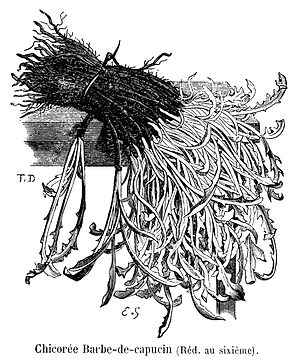WHAT iS ENDIVE ?
Its origin
Endive has a unique story—it’s a youngster in the vegetable world, which is ironic considering that the root it’s grown from, called chicory, is one of the earliest plants cited in recorded literature.
Endive, on the other hand, was a relatively recent discovery, thanks to a lucky accident. In 1830, a farmer named Jan Lammers in Brussels, Belgium, stored some chicory roots in his cellar because he was planning to dry and roast them for coffee (it was commonly used as an additive or coffee substitute). But then he left his farm for several months to serve in the Belgian War of Independence, and when he returned he discovered that his chicory roots had sprouted small, white leaves that were tender, crunchy, and delicious.

A Belgian botanist named Brézier then went on to refine cultivation to the point where it could be grown commercially. Markets in Brussels began carrying endive in 1846, and then in 1872 it was introduced in Paris and it became so popular that it was nicknamed “white gold.”
Belgian endive is known in Dutch as witloof or witlof (« white leaf »), endive in the United States, indivia in Italy, endivias in Spain, chicory in the UK, as witlof in Australia, endive in France, and chicon in parts of northern France, in Wallonia and (in French) in Luxembourg. It has a small head of cream-colored, bitter leaves. It is grown completely underground or indoors in the absence of sunlight to prevent the leaves from turning green and opening up (etiolation).
The smooth, creamy white leaves may be served stuffed, baked, boiled, cut and cooked in a milk sauce, or simply cut raw. The tender leaves are slightly bitter; the whiter the leaf, the less bitter the taste. Belgium, France, Holland export chicon/witloof to over 40 different countries.
our vietnam production
ENDIVE is certainly the world's most complicated and difficult vegetable to grow.
In a first step, we cultivate our roots in traditional field in Vietnam from seeds. When the chicory plants reach maturity, we harvest the plants, throw away the leaves, and bring the roots into our cold room, where they are stored for being used in the second step: the Forcing.
Forcing consists of placing chicory roots in what we call a forcing room, with specific humidity and temperature conditions, in complete darkness, where we use an innovative hydroponic process. Endives are sprouting from the roots, and are ready to be consumed within three weeks after entering the forcing room.
This process guarantees the high quality of our vegetables thanks to a safe cultivation way. It offers an alternative way to produce high quality vegetables without chemical fertilizers or pesticides.




